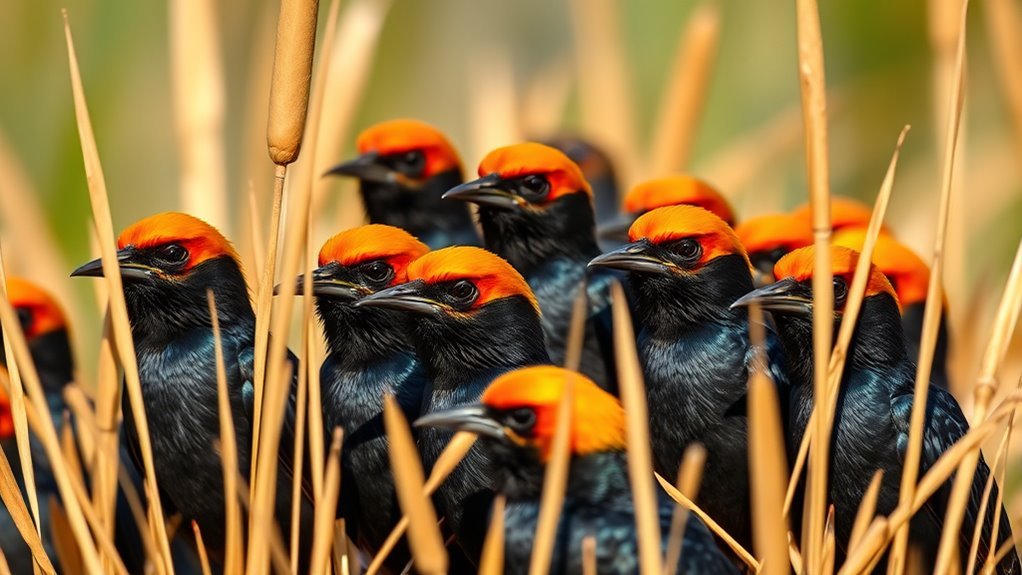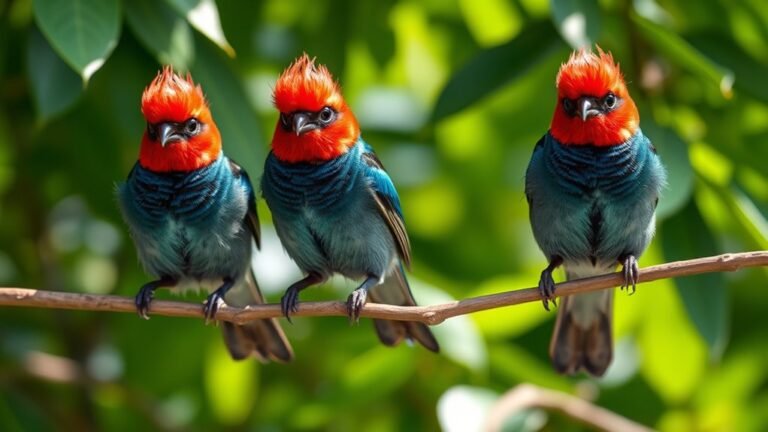Black Birds With Distinctive Red Heads: Common Species
When you see black birds with bright red heads, you are observing interesting species with unique traits. The Red-Headed Woodpecker is skilled at finding food, while the Red-Winged Blackbird shows unique behaviors during mating in wetlands. These birds play important roles in their environments. Their differences prompt questions about what they do and how they interact with their surroundings and each other.
Key Takeaways
- The Red-Headed Woodpecker is known for its striking white body and vibrant red head, inhabiting open woodlands.
- Baltimore Orioles have bright orange-yellow feathers and black heads, making them vibrant but not fitting the "red-head" criteria.
- The Red-Winged Blackbird features a black body with red and yellow shoulder patches, but lacks a red head.
- The Yellow-Headed Blackbird has a distinctive yellow head with a black body, also not fitting the "red-head" definition.
- Common Grackles exhibit shiny feathers, which can include hues of blue and black, but do not possess a red head.
Red-Headed Woodpecker

The Red-Headed Woodpecker is one of the most colorful birds in North America. These birds live in open woodlands with dead trees. These trees are important because they provide nesting sites and food.
Red-Headed Woodpeckers like areas with a mix of deciduous trees and open spaces, which help them find food easily.
These woodpeckers eat insects, fruit, and nuts. They use their strong beaks to dig into tree bark to find hidden food. They can also store food by making holes in trees. This behavior shows their intelligence and adaptability.
Watching these birds helps you appreciate nature and learn about the importance of biodiversity in our environment.
Common Grackle
Common Grackles are abundant birds found in North America. They've shiny feathers that change color from blue to black in sunlight. You can spot them easily in various environments.
Here are some behaviors you may notice:
- They often search for food in groups.
- Their diet includes insects, seeds, and fruits.
- They show intelligence when finding food.
- They make loud sounds, especially during mating season.
Learning about common grackles enhances your understanding of their role in nature.
These birds are visually appealing and provide insight into social interactions within bird communities. Enjoy observing their lively behavior!
Red-Winged Blackbird

The Red-Winged Blackbird is a colorful bird found throughout North America. It has bright red and yellow shoulder patches. You can often see these birds in wetlands and marshes.
Male Red-Winged Blackbirds establish territories and sing to attract females. They often perform impressive aerial displays. Female Red-Winged Blackbirds build nests in thick vegetation. They lay three to six eggs and protect them fiercely.
In terms of diet, Red-Winged Blackbirds mainly eat insects, seeds, and grains. During the breeding season, they prefer invertebrates. Their ability to adapt allows them to thrive in different environments.
Watching these vibrant birds enhances your appreciation of their role in nature.
Baltimore Oriole
Baltimore Orioles are known for their bright orange-yellow feathers and black heads. They're a popular sight for birdwatchers and nature lovers.
These birds migrate thousands of miles each year. When you observe them, you'll see their unique feeding habits:
- They sip nectar from flowers.
- They search for insects on trees.
- They eat ripe fruits, such as mulberries.
- They collect caterpillars for their young.
Their bright colors and beautiful songs create a strong connection to nature. Learning about Baltimore Orioles helps you appreciate these birds more and feel a sense of community with other bird enthusiasts.
Enjoy the experience of watching and studying these amazing creatures.
Yellow-Headed Blackbird

Five unique species of blackbirds live in North America. The Yellow-Headed Blackbird is notable for its striking appearance and behavior. This bird prefers wetland habitats, particularly areas with reeds and cattails for nesting.
Its bright yellow head stands out against its black body, making it easy to identify. Yellow-Headed Blackbirds often forage in small groups, searching for insects and seeds.
Males are very vocal during the breeding season, using calls to attract mates and defend their territory. Learning about their habitats and behaviors can help you appreciate this beautiful species and foster a greater connection with nature.
Black-Crested Titmouse
The Black-Crested Titmouse is a small bird with unique features and lively behavior. This bird is known for its charming actions, making it a delight to watch.
Here are key points about its behavior and habitat:
- The Black-Crested Titmouse lives in deciduous and mixed forests.
- It prefers areas with many oak trees for finding food and nesting.
- You'll often see it hopping between branches to search for insects and seeds.
- It sings a variety of sounds, which adds to its presence.
Whether it's flitting about or sitting confidently on a branch, this bird's engaging traits help you feel connected to the natural world.
Observing the Black-Crested Titmouse enhances your birdwatching experience and deepens your appreciation for nature.
Rose-Breasted Grosbeak
The Rose-Breasted Grosbeak is a memorable bird in North America. It has distinct black and white feathers and a bright rose-colored chest.
This species lives mainly in deciduous forests and shrubby areas where it can nest and find shelter. It prefers places with thick vegetation, often near gardens or open woodlands.
The Rose-Breasted Grosbeak has a varied diet, eating seeds, fruits, and insects. You can often find these birds searching for food on the ground or at feeders, using their strong bills to crack seeds.
Watching them can enhance your appreciation for nature and help you connect with the wildlife around you.
Frequently Asked Questions
What Habitats Do These Birds Prefer for Nesting?
These birds prefer various habitats, primarily nesting in marshlands and wooded areas. They like dense vegetation, which provides protection and rich food sources for their young. This choice of nesting spot helps ensure the survival of their chicks.
How Can I Attract Them to My Backyard?
To attract birds to your backyard, place bird feeders filled with sunflower seeds. Also, install nesting boxes nearby. Keep your feeders clean and place them away from predators to encourage more visits and nesting. Enjoy watching the birds come to your yard!
What Do These Birds Typically Eat?
These birds eat seeds, fruits, and insects. Understanding their food preferences can help you create a suitable habitat for them. Providing the right food will make your space inviting and support local wildlife. Enjoy watching these birds thrive in your area.
Are These Species Migratory or Resident Year-Round?
Some birds stay in one place all year. Others move to warmer areas when it gets cold. This pattern shows how birds adapt to different climates. Recognizing these behaviors helps us appreciate their resilience and survival skills.
How Can I Identify Juvenile Birds of These Species?
To identify juvenile birds, look for specific features. Juveniles often have softer plumage that may appear paler than adult birds. Notice their size and the shape of their beak, as these details can provide important hints about their age. Observing these traits can help you distinguish juvenile birds from adults easily.

Hello, I’m Amelia White, the founder of birdsfanatic.com. As a lifelong bird enthusiast and spiritual seeker, I’ve always been fascinated by the mystical connections between birds and the human experience. On this site, I share my knowledge and insights into the symbolic meanings and spiritual significance of various bird species, exploring their roles in mythology, folklore, and cultural traditions. Join me on this journey into the world of birds, where we’ll discover the hidden wisdom and guidance that these magnificent creatures have to offer.







